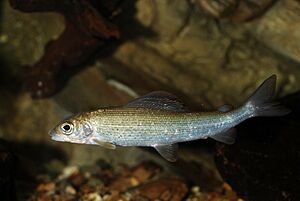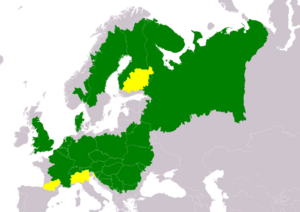Grayling facts for kids
Quick facts for kids Grayling |
|
|---|---|
 |
|
| Juvenile grayling | |
| Conservation status | |
| Scientific classification | |
 |
|
| Range of T. thymallus Resident Extant & Introduced (resident) |
The grayling or European grayling (scientific name: Thymallus thymallus) is a type of freshwater fish. It belongs to the salmon family, called Salmonidae. This fish is the only species of its kind, Thymallus (the graylings), that naturally lives in Europe. You can find it in many places, from the United Kingdom and France all the way to the Ural Mountains in Russia. It also lives in the Balkans in the southeast. However, it doesn't live in the very southern parts of Europe. In 1948, some grayling were brought to Morocco, but they didn't seem to settle there.
Contents
About the European Grayling
The grayling can grow quite large! The biggest one ever recorded was about 60 cm (24 in) long and weighed up to 6.7 kg (15 lb). It looks like other Thymallus fish. You can tell the European grayling apart from the similar Arctic grayling because it has 5 to 8 spines on its back fin (called the dorsal fin) and 3 to 4 spines on its bottom fin (called the anal fin). The Arctic grayling doesn't have these spines. European grayling also have fewer soft rays in these fins. Some grayling have been known to live for up to 14 years!
Where Grayling Live and What They Eat
Grayling love cold, clean, and fast-flowing rivers. But you can also find them in lakes. Sometimes, they even live in slightly salty water around the Baltic Sea. They are omnivores, which means they eat both plants and animals. Their diet includes plants, crustaceans (like tiny shrimp), insects, spiders, mollusks (like snails), tiny water animals called zooplankton, and even smaller fish like Eurasian minnows. Bigger fish, such as the huchen, sometimes hunt grayling.
Importance and Protection
Along with the Arctic grayling, the European grayling is an important fish. People raise them on farms, and they are also popular for sport fishing. The grayling is a protected species. It is listed in Appendix III of the Bern Convention, which helps protect wildlife. Sadly, in the Baltic Sea, the grayling has become critically endangered, meaning it's at a very high risk of disappearing.
The name "grayling" is often used for all fish in the Thymallus group. So, to be clear, T. thymallus is sometimes called the European grayling.
Angling for Grayling
The grayling is often called the 'lady of the stream' by anglers (people who fish). In the past, some anglers in Europe didn't like grayling. They wrongly thought that grayling stopped trout from living in parts of rivers and streams. However, studies have shown that grayling and trout actually eat different foods. They also usually prefer different small areas within rivers. But they do share similar living spaces with smaller, less predatory trout.
Fishing Seasons and Methods
In England and Wales, you can fish for grayling during the coarse fishing season, which runs from June 16th to March 14th. They offer exciting sport, especially with a fly, when the trout fishing season is closed. In Scotland, there is no closed season for grayling, especially where they have been introduced. There are no grayling in Ireland.
Some popular flies for catching grayling include the grayling witch, klinkhamers, different types of nymphs, and 'red tags'. Other flies used for trout also work well. Flies that look like small pink shrimps have also been found to be very useful.
One special fishing method is called 'Czech-nymphing'. This method is helpful when grayling gather together in colder times. It involves moving a series of Czech nymphs (small, weighted flies) under the tip of the fly rod. You let the nymphs float with the river's current, and they should encourage the grayling to bite. Fly-anglers might wade into the river to do this, reaching deeper water. Wading usually doesn't scare grayling. They are generally less cautious than trout and are not as easily bothered by people.
In France, the fishing season for grayling also has limits depending on various things. The Allier River is one of the few places in Southern Europe where the common grayling lives naturally.
Images for kids



